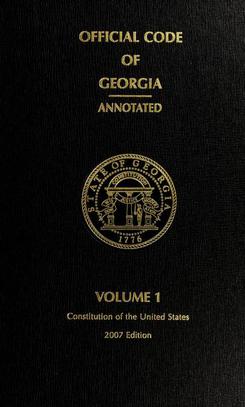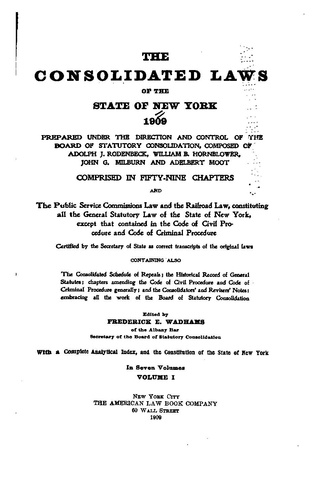
The United States Code is the official codification of the general and permanent federal statutes of the United States. It contains 53 titles. The main edition is published every six years by the Office of the Law Revision Counsel of the House of Representatives, and cumulative supplements are published annually. The official version of these laws appears in the United States Statutes at Large, a chronological, uncodified compilation.
In law, codification is the process of collecting and restating the law of a jurisdiction in certain areas, usually by subject, forming a legal code, i.e. a codex (book) of law.

The Appellate Division of the Supreme Court of the State of New York is the intermediate appellate court in New York State. The state is geographically divided into four judicial departments of the Appellate Division. The full title of each is, using the "Fourth Department" as an example, the "Supreme Court of the State of New York, Appellate Division, Fourth Judicial Department".

The Official Code of Georgia Annotated or OCGA is the compendium of all laws in the state of Georgia. Like other state codes in the United States, its legal interpretation is subject to the U.S. Constitution, the U.S. Code, the Code of Federal Regulations, and the state's constitution. It is to the state what the U.S. Code is to the federal government.

The Uniform Law Commission (ULC), also called the National Conference of Commissioners on Uniform State Laws, is a non-profit, American unincorporated association. Established in 1892, the ULC aims to provide U.S. states with well-researched and drafted model acts to bring clarity and stability to critical areas of statutory law across jurisdictions. The ULC promotes enactment of uniform acts in areas of state law where uniformity is desirable and practical. The ULC headquarters are in Chicago, Illinois.

David Dudley Field II was an American lawyer and law reformer who made major contributions to the development of American civil procedure. His greatest accomplishment was engineering the move away from common law pleading towards code pleading, which culminated in the enactment of the Field Code in 1850 by the state of New York.

The Civil Court of the City of New York is a civil court of the New York State Unified Court System in New York City that decides lawsuits involving claims for damages up to $25,000 and includes a small claims part for cases involving amounts up to $10,000 as well as a housing part for landlord-tenant matters, and also handles other civil matters referred by the New York Supreme Court. The court has divisions by county (borough), but it is a single citywide court.
Fair debt collection broadly refers to regulation of the United States debt collection industry at both the federal and state level. At the Federal level, it is primarily governed by the Fair Debt Collection Practices Act (FDCPA). In addition, many U.S. states also have debt collection laws that regulate the credit and collection industry and give consumer debtors protection from abusive and deceptive practices. Many state laws track the language of the FDCPA, so that they are sometimes referred to as mini-FDCPAs.
The New York State Bar Association (NYSBA) is a voluntary bar association for the state of New York. The mission of the association is to cultivate the science of jurisprudence; promote reform in the law; facilitate the administration of justice; and elevate the standards of integrity, honor, professional skill, and courtesy in the legal profession.

The California Codes are 29 legal codes enacted by the California State Legislature, which, alongside uncodified acts, form the general statutory law of California. The official Codes are maintained by the California Office of Legislative Counsel for the Legislature. The Legislative Counsel also publishes the official text of the Codes publicly at leginfo.legislature.ca.gov.

The law of California consists of several levels, including constitutional, statutory, and regulatory law, as well as case law. The California Codes form the general statutory law, and most state agency regulations are available in the California Code of Regulations.
Civil procedure in the United States consists of rules that govern civil actions in the federal, state, and territorial court systems, and is distinct from the rules that govern criminal actions. Like much of American law, civil procedure is not reserved to the federal government in its Constitution. As a result, each state is free to operate its own system of civil procedure independent of her sister states and the federal court system.

The California Code of Civil Procedure is a California code enacted by the California State Legislature in March 1872 as the general codification of the law of civil procedure in the U.S. state of California, along with the three other original Codes. It contains most California statutes that govern the filing and litigation of lawsuits in the Superior Courts of California, as well as legal notices that must be given in a variety of circumstances. It also includes statutes of limitations that control the period of time during which a lawsuit may be commenced. The Code originally governed the legal profession, but those were later moved to the Business and Professions Code.
The law of Illinois consists of several levels, including constitutional, statutory, and regulatory law, as well as case law and local law. The Illinois Compiled Statutes (ILCS) form the general statutory law.
The law of the U.S. state of Georgia consists of several levels, including constitutional, statutory, and regulatory law, as well as case law and local law. The Official Code of Georgia Annotated forms the general statutory law.
The law of New Jersey consists of several levels, including constitutional, statutory, regulatory, case law, and local law.
The law of Washington consists of several levels, including constitutional, statutory, regulatory and case law, as well as local ordinances. The Revised Code of Washington forms the general statutory law.

The Consolidated Laws of the State of New York are the codification of the permanent laws of a general nature of New York enacted by the New York State Legislature.
Georgia v. Public.Resource.Org, Inc., No. 18-1150, 590 U.S. ___ (2020), is a United States Supreme Court case regarding "whether the government edicts doctrine extends to—and thus renders uncopyrightable—works that lack the force of law, such as the annotations in the Official Code of Georgia Annotated" (OCGA). On April 27, 2020, the Court ruled 5–4 that the OCGA cannot be copyrighted because the OCGA's annotations were "authored by an arm of the legislature in the course of its legislative duties"; thus the Court found that the annotations fall under the government edicts doctrine and are ineligible for copyright.
The Code of the District of Columbia is the codification of the general and permanent laws relating to the District of Columbia. It was enacted and is revised by authority of the Congress of the United States.









